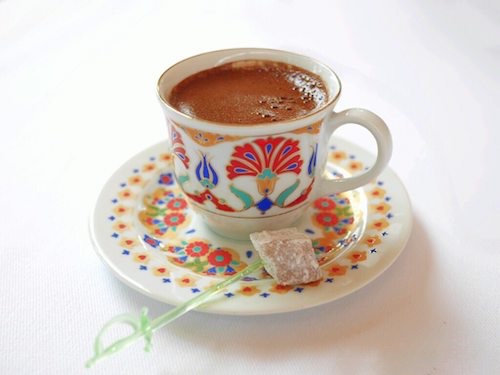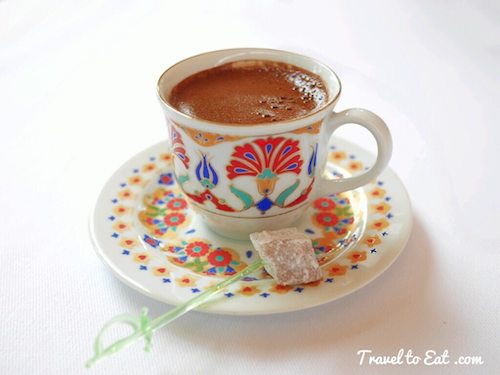
Because both Turkish coffee and tea are an important Middle Eastern social ritual, I have decided to commit a post to them. Turkish coffee is a method of preparing coffee, not depending on the type of coffee, although the beans are usually darkly roasted Arabica, indigenous to Ethiopia, but now grown all over the world. Roasted and then finely ground coffee beans are boiled in a pot (cezve), usually with sugar, and served in a cup where the grounds are allowed to settle. The earliest evidence of coffee drinking comes from 15th-century Yemen. By the late 15th century and early 16th century, coffee had spread to Cairo and Mecca. In the 1640s, the Ottoman chronicler İbrahim Pecevi reported the opening of the first coffeehouse in Constantinople. The word ‘coffee’ comes from the Arabic word قهوة qahwah. The importance of coffee in Turkish culture is evident in the words ‘breakfast’, kahvaltı, whose literal meaning is “before coffee” (kahve ‘coffee’ + altı ‘under/before’) and ‘brown’, kahverengi, whose literal meaning is, “the color of coffee”.
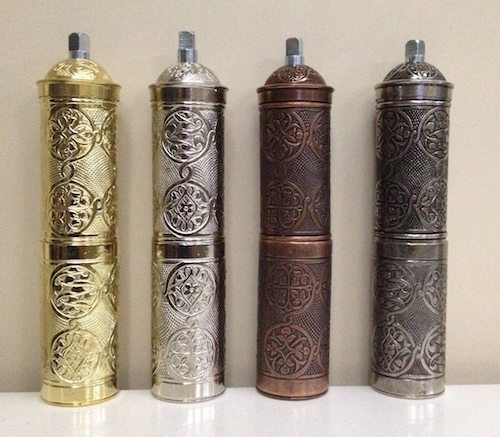
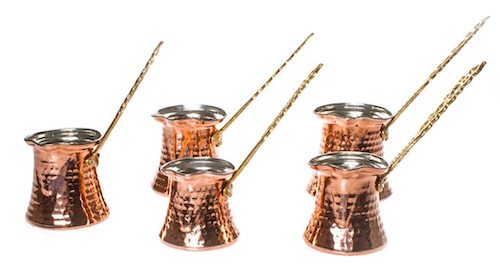
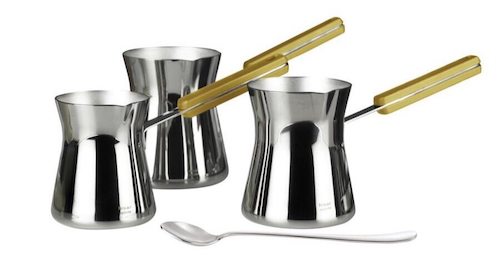
The coffee can be ground in an electric grinder but I find the texture too coarse. I personally have two of the ungainly Turkish grinders, one for pepper and a second for coffee. Despite their apparent mechanical simplicity, their are no better grinders for coffee or spices. Turkish coffee is normally prepared using a narrow-topped small boiling pot called an kanaka, cezve, džezva, xhezve, jazzve or μπρίκι (bríki) (basically a tiny ewer), a teaspoon and a heating apparatus. Of course the original Cezve were made of copper; the more contemporary models are constructed of stainless steel. The ingredients are very finely ground coffee, sometimes cardamom, cold water and (if desired) sugar. There are different sizes to allow for preparation for different numbers of people. The size issue revolves mainly around the foam on top of the coffee, a pot made for four will not produce enough foam even for two.
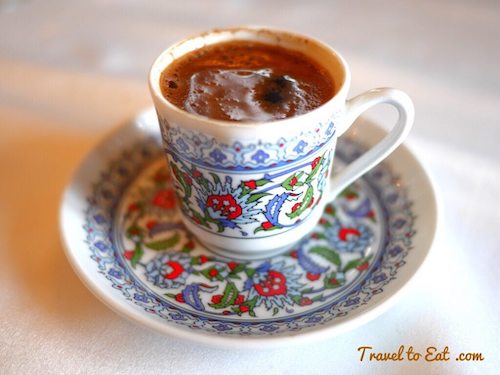
When properly made, a delicious foam forms at the top, which is essential to any Turkish coffee. To properly make Turkish coffee, you need the right equipment: the long handled pot called “cezve” and small coffee cups called “fincan”. The size of the pot is significant. It must hold almost double the amount of the water used to have adequate “room” on the top for the foam to rise. Into your “cezve”, put one coffee cup of water for each person, 1 heaped teaspoon of coffee and 1 rounded teaspoon or less of sugar. The Turkish terms and approximate amounts are as follows: sade or sekersiz (plain; no sugar), az şekerli (little sugar; half a level teaspoon of sugar), orta şekerli (medium sugar; one level teaspoon), and çok şekerli (a lot of sugar; one and a half or two level teaspoons). This is a bit odd since in Europe sugar is added to expresso and Cappuccino after serving, but in the Mideast you need to specify at the time of ordering. Stir well, put over very low heat and bring slowly to boil. As it gently start to boil, the froth forms on top and rises. Just before it overflows, remove and divide the froth into the cups. Then bring to boil again and divide the rest out to the cups. Though not the traditional way, a little hot milk may also be added to Turkish coffee in some parts of Turkey. Boiling too long or too hot can cause the coffee to become bitter and/or lose the foam.
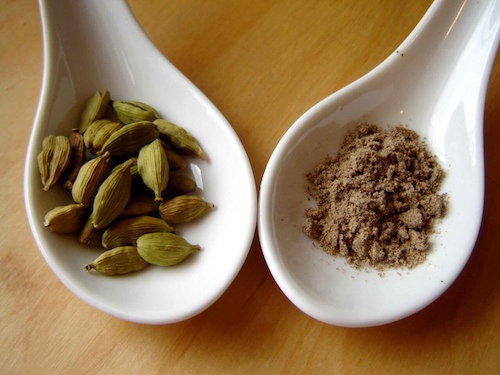
Turkish coffee and tea are sometimes mixed with cardamon, even more commonly in in the Arabic world. Sometimes “Turkish coffee” and “Arabic coffee” are used interchangeably, but they are different. Turkish coffee is dark and thick, with foam on top and grounds at the bottom. It’s often sweet when Arabic coffee is almost never sweetened. A common ratio of cardamon to coffee is 3 parts coffee to one part cardamom, and you can adjust to taste. The cardamom can be ground with the coffee (the easiest method) or crushed cardamom can be added near the end of cooking. If you like extra cardamom, you can do both. Known in Hindi as ilaichi, cardamom has a sweet and pungent initial taste or rasa, and has a pungent aftertaste. Cardamom refers to several plants of the similar genera Elettaria and Amomum in the ginger family Zingiberaceae. Both genera are native to India, Pakistan, Nepal, and Bhutan; they are recognized by their small seed pods, triangular in cross-section and spindle-shaped, with a thin, papery outer shell and small black seeds. The two types of cardamom, κάρδαμομον (green) and ἄμωμον (black), were distinguished in the fourth century BCE by the Greek father of botany, Theophrastus. Some of his unknown informants told him these varieties came to Greece from the land of the Medes in northern Persia, while others were aware it came originally from India. I have tried cardamon in both coffee and tea and I actually like it as a change of pace in coffee.
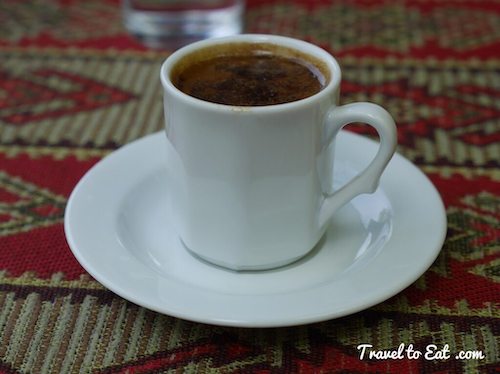
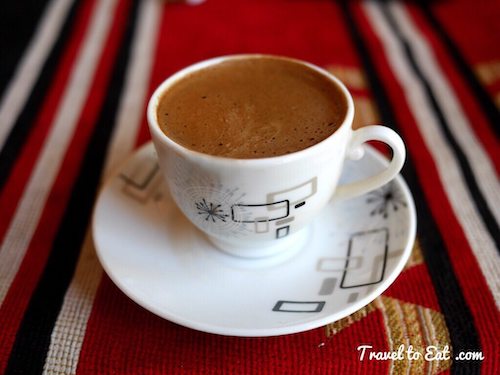
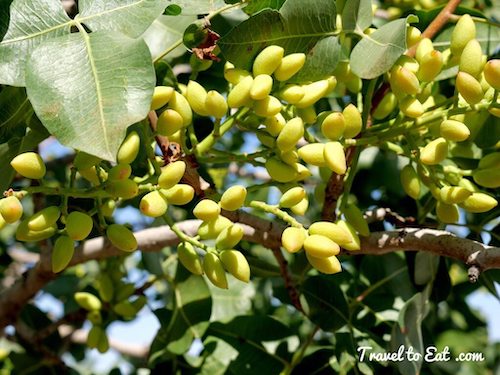
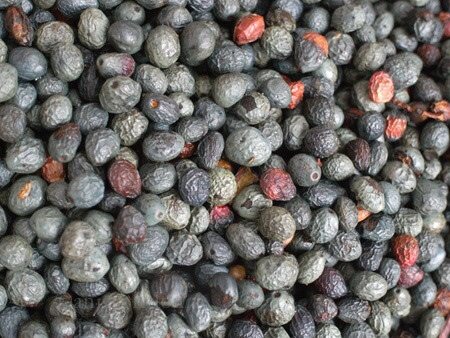
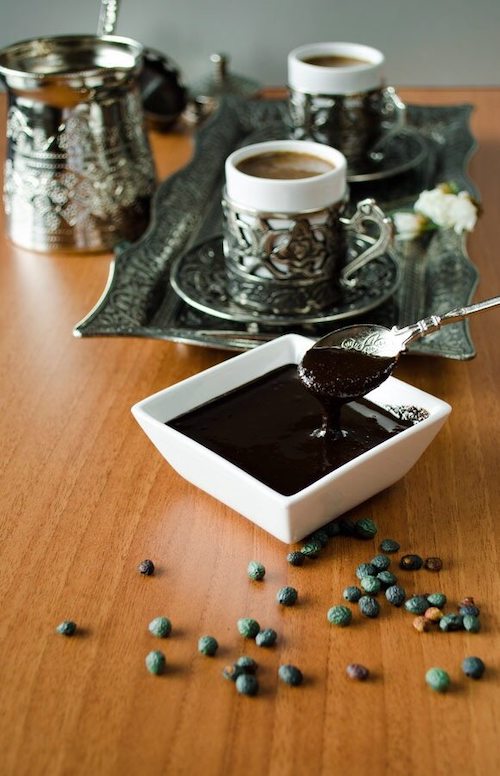
Menengiç Coffee is an aromatic Southern Turkish specialty which features Menengic, known commonly as terebinth and turpentine tree, which is a wild species of Pistacia, and wildly grown in Southern Turkey, part of the national flora. Cooked with milk, you can certainly get the wonderful pistachio taste, a unique experience. I personally find the taste less than enjoyable and prefer a mix of coffee with the Menengiç, in a a ratio of 1:1. In this way you get the lovely pistachio flavor mixed with the beautiful taste of coffee. In addition, there is no foam with Menengiç while mixed with coffee, you also get the foam (compare the photos seen above for the difference).
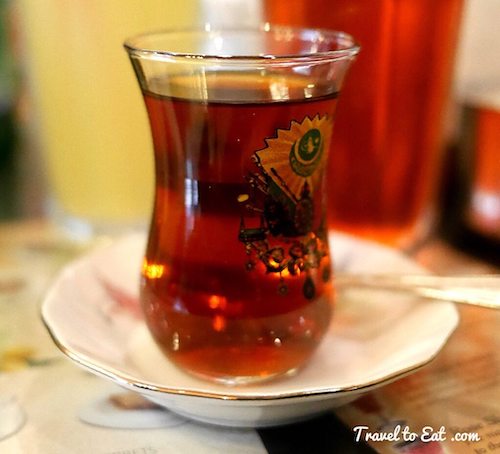
No one is sure of the exact inventor of tea, but Chinese legends attribute the invention of tea to Shennong in 2737 BC. Tea originated in China as a medicinal drink. It was first introduced to Portuguese priests and merchants in China during the 16th century. Drinking tea became popular in Britain during the 17th century. The British introduced it to India, in order to compete with the Chinese monopoly on the product. Tea plants are native to East and South Asia, and probably originated around the meeting points of the lands of north Burma and southwest China. Turkish tea, called çay (pronounced Chai), is black tea which is consumed without milk, is produced on the eastern Black Sea coast, which has a mild climate with high precipitation and fertile soil. Turkish tea is typically prepared using two stacked kettles (çaydanlık) specially designed for tea preparation. Water is brought to a boil in the larger lower kettle and then some of the water is used to fill the smaller kettle on top and steep (brew) several spoons of loose tea leaves, producing a very strong tea. Tea is drunk from small glasses to enjoy it hot in addition to showing its color, with cubes of (Turkish: kesme şeker) beet sugar.
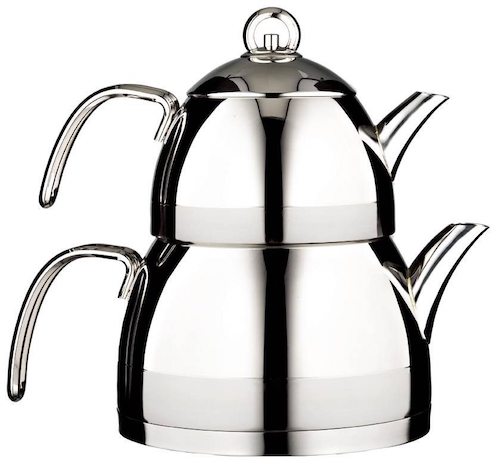
The vessels for Turkish tea (Caydanlik) involve a double boiler design with the water in the bottom and the steeped tea above. A little unusual as a teapot but useful to dilute the tea if it is too strong. Tea is drunk partly because people like tea but also because it is more inexpensive than coffee. All of this may seem like excessive verbiage on a the subject of beverages but believe me when I tell you that these rituals are the linchpins of acceptance in Turkey and the Middle East. Failure to accept these protocols will brand you as an insensitive outsider and prevent you from really enjoying Turkey. As a final small ritual, when you are finished with your coffee, turn the cup upside down and let the grounds drain on the saucer. A quick glance at the residual grounds at the bottom of the cup may provide advice on your future or give other information about your life.
References:
Cezve: http://cezvefiyatlari.blogspot.com/2013/10/bakr-cezve-fiyatlar.html
Cezve: http://www.opema.com.tr/uoz.php?id=156
Caydanlik: http://www.emsanshop.com/emsan-aragon-paslanmaz-celik-caydanlik/
Cardoman: http://vedichealing.com/cardamom-the-health-benefits-of-this-exotic-and-aromatic-spice/
Ozlem’s Directions for Turkish Coffee: http://ozlemsturkishtable.com/2013/06/deliciously-frothy-turkish-coffeeturk-kahvesi-more-than-a-drink/
Menengiç: http://www.anissas.com/menengic-a-turkish-coffee-that-is-not-coffee-at-all/
Menengiç: http://www.giverecipe.com/menengic-coffee.html

